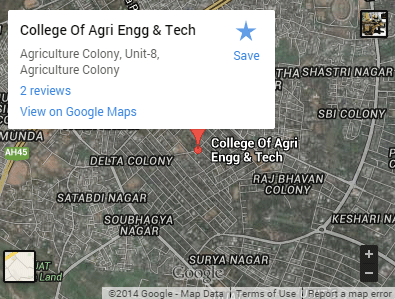Objective of the Project:
Vegetable being a rich and cheap source of vitamins and minerals, occupy an important place in the food of Indian consumers. The country is producing about 98 million tonnes (MT) of vegetables from an area of around 6.07 million ha. At present there is a lack of sufficient focus and farmers confront a number of problems. If information pertaining to different aspect of vegetable production is provided in user friendly way, it will have a great importance in the present scenario of globalization as it aims to provide appropriate advice in vegetable production to the farmers.
To place comprehensive information of sustainable vegetable production and marketing strategies useful to farmers and agriculturists on the website preferably on www.caet.nic.in.
Vegetable Production Technology:Diverse soil and climatic conditions prevailing in different parts of the country offer scope for cultivation of a variety of crops in India. The major aspects of crop production of selected vegetables taken in the system are:
- Variety/Hybrids
- Climate and Soil
- Field Preparation
- Nursery Management
- Intercultural, Weed and Irrigation Management
- Nutrient Management
- Insect Management
- Disease Management
- Intercropping
- Marketing Information
- Harvest and Post Harvest
1)E-agrotech
E-agrotech software is prepared for disseminating production techniques of various crops by use of information technology. The project is sponsored by Ministry of Information Technology, New Delhi and Govt. of Odisha. The Software is bi-lingual and is developed for farmers, scientists, teachers and KVKs. No special training is required know the contents of the software.
The software contains information about almost every aspects of crop production technologies. Some aspects like quantity of chemical fertilisers and time of sowing is based on crop production techniques of MP. For other regions, these aspects can be modified according to their agroclimatic zones. The software package contains different modules like kharif, rabi, diagnosis, cropping system, fruit crop and resources available.
Kharif: In Kharif module, production technologies of paddy, soybean, maize, groundnut, sesamum, pigeon peas, sunflower, moong, urd, kodo, kutki, cotton and sorghum are given.
Rabi: In Rabi module, production technologies of wheat, chickpea, mustard, sunflower, safflower and maize are given. Fruit crop: In fruit crop, production technologies and management aspects like propagation, orchard plan, after care, nutrition, irrigation, disease and insect control, variety and harvesting are given. Diagnosis module, questions based on crop growth and establishment, insect, disease and weed problems are given and accordingly necessary recommendations are suggested by the software.
2)e-IPMe-IPM is developed in visual basic 6.0 as front end and MS access 2000 as backend. It is multimedia bilingual (English/Hindi) software developed for pest, disease, nematode, weeds, and nutrient disorder management of major oilseed and pulse crops of central India. In the e-ipm, each crop module is separate and includes information pertaining to integrated pest management of the selected crop. The e-ipm incorporates information on natural enemies, resistant varieties, agronomic practices and ipm modules of each crop. e-IPM is a user friendly software and a person having simple basic knowledge of computer can browse the contents of the software. It has multimedia effects like audio, still photos with zooming effects, movies, and life cycle diagrams. It includes a user interactive diagnosis module for pest and disease problem and a search module with different searching options using common name or scientific name for pest management. Apart from all these, it is a resource of information regarding seeds, fertilizers, bio-pesticides centers, storage and technical enquiry.
The software is having mechanism for updating and incorporating new technologies as and when needed. Efforts have been made to cover most of the aspects of integrated pest management of groundnut, cotton, soybean, sunflower, safflower, mustard, sesamum, niger, chickpea, moong, urd and pigeon pea. The information given are reviewed and edited by plant protection experts.
3)NISAGENET Project (National Information System on Agricultural Education Network in India) The major activities and the technical programme of the project are as follows:- Collection and compilation of data on Agricultural Education.
- Designing, Development and Implementation of NISAGENET software on the Internet.
- Publications of annual statistical bulletins on Agricultural Education.
- Supply of statistical data to Ministry of HRD as per their requirements
Useful Links
- Indian Council of Agricultural Research(ICAR)
- Orissa University of Agriculture & Technology
- Central Agricultural University,Imphal,Manipal
- Tamil Nadu agricultural University
- Kerala Agricultural University
- Punjab Agricultural University,Ludhiana
- Swami Keshwanand Rajasthan Agricultural University,Bikaner
- Acharya N.G Ranga Agricultural University,Hyderabad
- Orissa Agricultural Engineers' Service Association
- INDIA TOGETHER: AGRICULTURE
- Agricultural Implements 1
- Agricultural Implements 2
- e-Krishi Shiksha
Contact Details
College of Agricultural Engineering and Technology,Orissa University of Agriculture & Technology,
Bhubaneswar - 751003
Phone: +91674-2562360 (Office);
+91 9437205952(Mobile)
E_mail: caetdean@gmail.com
Contact Hour:: Monday - Friday: 9:00 AM to 5:00 PM
